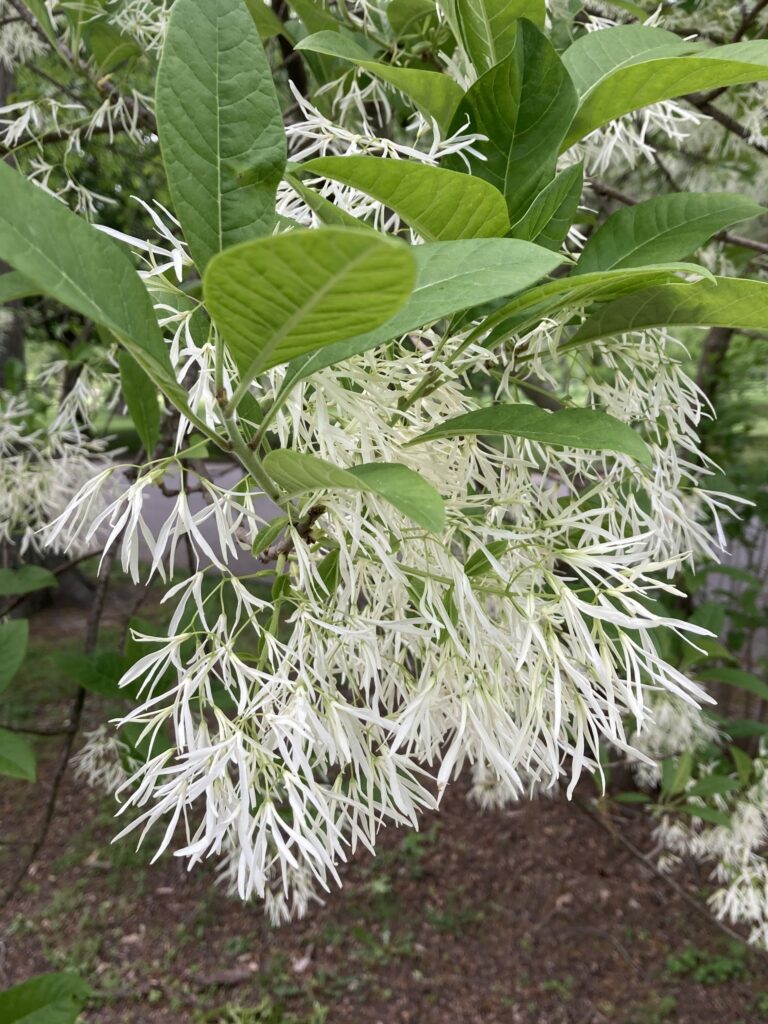By: Mark Halpin, Forestry Manager
Chionanthus virginicus, white fringetree, has one of the most unusual flower displays of any North American flowering tree (the only serious competition comes from smoketree, Cotinus obovatus). Also called “old man’s beard” for this unique characteristic, the flowers have four very thin lobes, about an inch long, and are so profuse and fine as to resemble hair from a distance. On closer inspection they are even more fascinating, perhaps suggesting enlarged snowflake crystals (chion- comes from the Greek word for “snow”). And a closer inspection is warranted not only for their beauty, but their pleasant fragrance. It is light and sweet, and can waft on the air for a good distance if a large specimen is present.
Fringetree is an adaptable and tough plant, and tolerant of air pollution, road salt and clay soil, full sun or part shade (as is usually the case, poor drainage is its Achilles’ heel). Usually a multi-stemmed “is it a small tree or large shrub?” in St.Louis, it grows to a height and spread of 10-20 feet (30 in exceptional cases or further south), so it can fit almost anywhere and is a great choice for planting under power lines. It can be maintained as a single stem, more “tree form” plant with a little diligent pruning, making it a good candidate for street tree use and an excellent replacement for Callery pear. With all of these characteristics taken into account – and let’s throw in its clean, yellow fall color just for good measure – it’s surprising it hasn’t become more popular as an ornamental tree. It’s still a beautiful oddity, a conversation piece beloved by plant nerds (and birds, for the small dark purple berries the female plants bear in fall).
There is some controversy surrounding fringetree’s susceptibility to emerald ash borer (EAB) and whether it should still be planted. The Chionanthus genus is closely related to the ash (Fraxinus) genus, both being members of the Oleaceae family. EAB will certainly attack the American fringetree and early findings were not promising. A more recent study (The Fate of Ornamental White Fringetree Through the Invasion Wave of Emerald Ash Borer and Implications for Novel Host Use by This Beetle – E A Ellison, D L Peterson, D Cipollini, published in Environmental Etymology, April 2020) indicates that fringetree will most often tolerate infestations. Furthermore, only 13% of the sampled trees were infested, indicating that EAB has a limited appetite for fringetree. Because of their small size, even badly infected specimens will never become the potentially lethal hazards that enormous ash trees often do. In most cases fringetree could be removed with a hand saw by an average homeowner. Infestations detected early enough can also be controlled by pruning out infected branches.
So keep planting fringetree! It’s a truly unique ornamental, and a versatile one as well. It fits into a wild native planting as well as a formal garden, and can stand on its own as a specimen tree or play a supporting role in an ensemble planting or shrub border. Currently blooming in St. Louis (5-10-21), go out and enjoy one soon.




